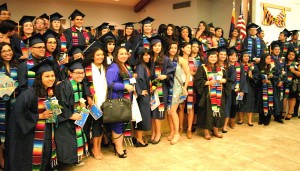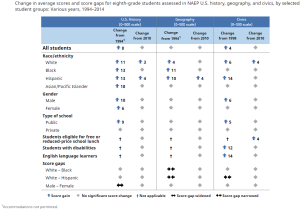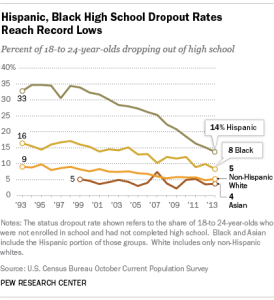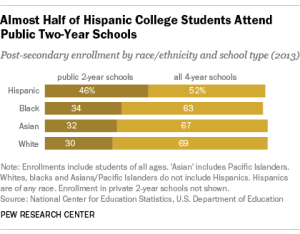
Students gather for a group photo during the 2014 Hispanic Convocation at Northern Arizona University. While Hispanic K-12 students have been making gains in the classroom in recent years, summer has become a crucial time for students to maintain their educational achievements as they prepare for community college and university admission. AmigosNAZ file photo ©2015
While Hispanic students have been making gains in classrooms during the year, summer becomes a crucial time to maintain those educational achievements
By Frank X. Moraga / AmigosNAZ
Summer vacation time is upon us. K-through-12 schools are busy completing their traditional school year, with high school, community college and four-year university graduation ceremonies rapidly coming to a close.
But while the school year is almost over, this is not the time to kick back for the next few months to allow the summer brain drain season to settle in. In fact, educators say this is a crucial time to maintain education excellence and prepare for the school year ahead.
During the summer, children lose one to three months of learning, according to a study by Dr. Harris Cooper, professor of psychology at the University of Missouri-Columbia in a story reported by www.familyeducation.com — http://school.familyeducation.com/summer/cognitive-processes/38453.html
In fact, children lose a month in math, Cooper said. His study also found that income has an impact on how much a student loses or gains in reading. Middle-class children actually gained in reading over the summer, while lower-income students experienced losses. Cooper attributes this to the enrichment activities that many middle-class kids participate in over the summer, such as camp and trips.
For Hispanic students, summer is a vital time to maintain the gains they have made in classrooms in recent years.
The National Assessment of Education Progress reports that Hispanic students appear to have bucked the trend of stagnant academic growth in U.S. history, civics and geography, according to an April 30 story written by Jessica Brown in Education Week.
While the 2014 NAEP report showed flat academic progress for students as a whole, Hispanic students as a group have made gains in U.S. history and geography since 2010 and in all three subject areas since the 1990s, when the first tests were administered.
So why the uptick in education performance?
Education experts pointed to better teaching strategies, better use of disaggregated data (that sorts test results into groups of students) and increased focus on policies for English-language learners as possible contributing factors, Education Week reported.
“It’s hard to say why the scores have risen (but) there has been a lot of attention to English-learners over the years to make sure they get intervention to get them to where they need to be,” Education Week quoted Allison Horowitz, a K-12 policy analyst at the Education Trust, a nonprofit organization that seeks to close the achievement gap between low-income or minority-race students and their more-advantaged peers.
The report also showed that academic gains by Hispanic students were also made on the NAEP math and reading assessments, which were administered in other years.
Other recent reports have also been showing positive trends for Hispanic youth.
Over the past decade, the Hispanic high school dropout rate has declined and college enrollment has increased, Jens Manuel Krogstad reported on May 26 in a Pew Research Center FactTank blog.
Over the past decade, the Hispanic high school dropout rate has dropped dramatically, Krogstad reported. The rate has reached a record low, dropping from 32 percent in 2000 to 14 percent in 2013 among those ages 18 to 24. Over the same time period, this has helped lower the U.S. national dropout rate from 12 to 7 percent – also a record low. However, the Hispanic dropout rate remains higher than the rate among blacks (8 percent), whites (5 percent) and Asians (4 percent).
Hispanics are also making big inroads in college enrollment, Krogstad reported. The number of Hispanics ages 18 to 24 enrolled in a two- or four-year college has more than tripled since 1993. In 2013, 2.2 million Hispanics were enrolled in college, up from 728,000 in 1993 – a 201 percent increase. By comparison, college enrollment increased by 78 percent among blacks and 14 percent among whites over the same time period. Today, Hispanics are the largest minority group on U.S. college campuses.
But while the number of Hispanics is growing in higher education, Hispanics continue to trail other groups in earning a bachelor’s degree.
In 2013, among Hispanics ages 25 to 29, just 15 percent of Hispanics had a bachelor’s degree or higher, Krogstad reported. By comparison, among the same age group, about 40 percent of whites had a bachelor’s degree or higher (as do 20 percent of blacks and 60 percent of Asians). This gap is due in part to the fact that Hispanics are less likely than some other groups to enroll in a four-year college, attend an academically selective college and enroll full-time.
Another reason Hispanics lag in bachelor’s degrees is that nearly half who go to college attend a public two-year community college, the highest share of any race or ethnicity, Krogstad reported. By comparison, among college-goers, 30 percent of whites, 32 percent of Asians and 34 percent of blacks go to a community college.
One bit of good news is that Hispanics are significantly less likely than other groups to have student debt, Krogstad reported.
About 22 percent of young Hispanic households (those headed by someone younger than 40) have education loans. The share is nearly twice as high among young white households (42 percent) and young black households (40 percent).
This is because, despite growing college enrollment, young Hispanics are not as likely to go to college as some other groups. And among those who do, Hispanics are more likely than others to attend community colleges, which generally have lower tuition than four-year schools.
One final piece of good news is that Hispanics cited education as a top issue during the 2014 election cycle, ranking alongside the economy and above health care and immigration in importance, according to the center’s survey.
Among Latino registered voters, 92 percent said education is an extremely (49 percent) or very (42 percent) important issue to them personally, and 91 percent said jobs and the economy is an extremely (46 percent) or very (45 percent) important issue.
Following these two issues is health care, which 86 percent of Latino voters rate as extremely (40 percent) or very (46 percent) important.
These three issues have consistently rated as the top three among Latino voters in Pew Research Center surveys (Krogstad, 2014), and the ranking is similar to that seen prior to the 2012 presidential election (Lopez and Gonzalez-Barrera, 2012).
Krogstad’s FactTank blog report can be found here.
The Pew Research Center’s full report on education can be found here.
Stopping Summer Brain Drain
So with Hispanic K-12 education achievement on the upswing, how do parents go about maintaining and expanding those gains made during the school year.
“Parents can help their kids retain educational skills,” said Cooper at the University of Missouri-Columbia. He suggests the following five tips to kick off a learning-filled summer.
1. Keep lots of books around and make regular trips to the library. Most libraries schedule special summer events for kids. Sign up your family.
2. Think about what your kids may be learning next year when you plan the family vacation. Talk with teachers to find out what they’ll be covering in class. If it’s a unit on the Civil War for example, you may want to schedule a visit to Gettysburg. If it’s geology, visit a national park.
3. Keep math in mind. Since kids lose more math skills than anything else over the summer, try to do some special planning to find math-related activities. For example, if you can’t decide whether to sign your child up for “Shakespeare’s Theater” or “Math Magic” at the local community center, go with the math.
4. Consider summer school or tutoring. Struggling kids can get a lot of different kinds of help from these programs. Summer school can also enrich and accelerate learning in areas where kids show a special interest.
5. Call the curriculum coordinator in your child’s school district, visit the school board office or contact the schools of education at local colleges and universities to find out what educational programs will be offered in your area over the summer.
Free websites can also help prepare students for the fall
The National Education Association reports that there are a number of free website that can help students across all grade levels.
For lower elementary school (K-2) they include:
- Fishing with Phonics – Help Garfield catch the most fish, and in the process practice your beginning and ending sounds.
- PBSKids.org – Be sure to check out all of your favorite PBSKids shows like Word Girl, Between the Lions, Super Why, Sid the Science Guy, Maya and Miguel and more. Many activities don’t require reading abilities, but some do.
- PictureMatch – Sort the pictures into the correct box based on the beginning-letter sounds, short-vowel sounds or long-vowel sounds.
For grades K-5, visit:
- Game Goo – An interactive set of games designed to build upon each other. Start at the bottom for younger students and move up through the games.
- FunBrain.com – FunBrain offers something for every student. Educational games have different levels so the practice can be customized. The site has areas dedicated to math and reading.
- Smithsonian Institute for Kids – Take a closer look at these engaging online exhibits from the Smithsonian Institution covering art, science & nature, history & culture and people & places.
For upper elementary, grades 3-5, visit:
- America’s Story – Presented by the Library of Congress. Students will get caught up in the interactivity of the site as they Meet Amazing Americans, Jump Back in Time, Explore the States, Join America at Play and See, Hear and Sing. Check it out.
- FactMonster– Discover this well-organized, kid-friendly resource for fun facts and outstanding games and quizzes.
- KidsReads – Looking for a few good books this summer? Check out this site with reviews and recommendations as well as sections devoted to popular book series.
For middle school, grades 6-8, visit:
- CoolMath.com – Don’t lose those hard-earned math skills this summer. Check out Cool Math to practice pre-algebra and algebra.
- MathPlayground – Created by a math teacher, this site offers games that require specific and complex skills, logic puzzles and an amazing supply of word problems. The games use manipulatives to help make even the most abstract math concepts clear. Topics include fractions, multiplication, percentages and more.
- National Park Service Web Rangers – Complete more than 4 dozen activities—puzzles, mysteries, quizzes, etc.—to earn your “WebRanger” status. The activities vary in difficulty level and topic (parks, animals, nature, people, history, science and puzzles).
- Smithsonian Institute for Kids – Take a closer look at these engaging online exhibits from the Smithsonian Institution covering art, science & nature, history & culture and people & places.
For the entire NEA list of websites, visit: http://www.neamb.com/professional-resources/beat-summer-brain-drain.htm



